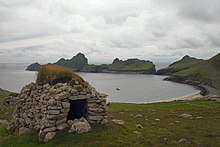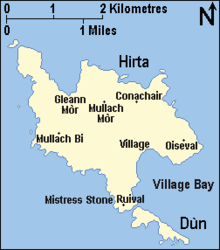| Revision as of 02:12, 1 June 2020 editNihiltres (talk | contribs)Edit filter managers, Administrators83,814 editsm →top: Replacing Other_uses2 template per TfDTag: AWB← Previous edit | Revision as of 15:07, 26 March 2021 edit undoTom.Reding (talk | contribs)Autopatrolled, Extended confirmed users, Page movers, Template editors3,896,618 editsm +{{Authority control}} (2 IDs from Wikidata), WP:GenFixes onTag: AWBNext edit → | ||
| Line 1: | Line 1: | ||
| {{ |
{{Other uses|Dun (disambiguation)}} | ||
| ] in the background at left.]] | ] in the background at left.]] | ||
| '''Dùn''' is an island in ], Scotland. It is nearly {{convert|1|mi|km|abbr=off}} long. Its name simply means "fort" in ] (for more information, see "]"), but the fort itself has been lost - old maps show it on Gob an Dùin ({{gbmappingsmall|NF109972}}), which is at the seaward end. | '''Dùn''' is an island in ], Scotland. It is nearly {{convert|1|mi|km|abbr=off}} long. Its name simply means "fort" in ] (for more information, see "]"), but the fort itself has been lost - old maps show it on Gob an Dùin ({{gbmappingsmall|NF109972}}), which is at the seaward end. | ||
| Line 17: | Line 17: | ||
| ==References== | ==References== | ||
| {{ |
{{Reflist}} | ||
| * Haswell-Smith, Hamish ''The Scottish Islands'' | * Haswell-Smith, Hamish ''The Scottish Islands'' | ||
| * Fisher, James & Waterston, George (Nov. 1941) ''The Breeding Distribution, History and Population of The Fulmar (Fulmarus glacialis) in the British Isles''. Edinburgh. The Journal of Animal Ecology, Vol. 10, No. 2 pp. 204–272. | * Fisher, James & Waterston, George (Nov. 1941) ''The Breeding Distribution, History and Population of The Fulmar (Fulmarus glacialis) in the British Isles''. Edinburgh. The Journal of Animal Ecology, Vol. 10, No. 2 pp. 204–272. | ||
| * MacLean, Charles ''Island on the Edge of the World: the Story of St. Kilda'', Canongate, 1977 | * MacLean, Charles ''Island on the Edge of the World: the Story of St. Kilda'', Canongate, 1977 | ||
| {{Commons |
{{Commons category|Dùn, St Kilda|Dùn}} | ||
| {{St Kilda}} | {{St Kilda}} | ||
| {{Authority control}} | |||
| {{ |
{{Coord|57.79463|-8.55296|type:landmark_region:GB_source:enwiki-osgb36(NF109972)|display=title}} | ||
| {{DEFAULTSORT:Dun, St Kilda}} | {{DEFAULTSORT:Dun, St Kilda}} | ||
Revision as of 15:07, 26 March 2021
For other uses, see Dun (disambiguation).
Dùn is an island in St Kilda, Scotland. It is nearly 1 mile (1.6 kilometres) long. Its name simply means "fort" in Scottish Gaelic (for more information, see "dun"), but the fort itself has been lost - old maps show it on Gob an Dùin (NF109972), which is at the seaward end.
Though Dùn is almost joined to Hirta at Ruiaval, the two islands are separated by Caolas an Dùin (the straits of Dùn). This prevents Soay sheep from Hirta straying onto the island, and thus it is more vegetated.
The small island is home to the largest colony of fulmars in Britain. Before 1828, St Kilda was their only British Isles breeding ground, but they have since spread and established colonies elsewhere, such as at Fowlsheugh.


Dùn, which protects Village Bay on Hirta from the prevailing south-westerly winds, was at one time joined to Hirta by a natural arch. MacLean (1972) suggests that the arch was broken when struck by a galleon fleeing the defeat of the Armada, but other sources, such as Mitchell (1992), provide the more credible (if less romantic) explanation that the arch was simply swept away by one of the many fierce storms which batter the islands every winter.
See also
- Cleit - a unique St Kildan form of stone shelter
- List of outlying islands of Scotland
References
- Haswell-Smith, Hamish The Scottish Islands
- Fisher, James & Waterston, George (Nov. 1941) The Breeding Distribution, History and Population of The Fulmar (Fulmarus glacialis) in the British Isles. Edinburgh. The Journal of Animal Ecology, Vol. 10, No. 2 pp. 204–272.
- MacLean, Charles Island on the Edge of the World: the Story of St. Kilda, Canongate, 1977
| Islands of St Kilda (Hiort) | |
|---|---|
| Islands | |
| Endemic species | |
| Unique sheep breeds | |
| History | |
57°47′41″N 8°33′11″W / 57.79463°N 8.55296°W / 57.79463; -8.55296
This article about a location in the Western Isles is a stub. You can help Misplaced Pages by expanding it. |